Observations of a Traveler: Japan
Reflections on unique cultural, customs, and characteristics of Edo
TRAVEL OBSERVATIONS
The Observations of Traveler series, is meant to summarize our observations and musings on each country we visit in sum, focusing on unique culture, customs, or physical characteristics that we notice. It is NOT meant to be a fully complete or accurate account of a people or a place. We are observers from the outside, often not knowing the language, and with limited time to interpret those people and places. Please do not take our observations with insult or as a truth. These observations are simply that, observations of travelers enjoying the experience and trying our best to understand the world around us.
Kind but Firm
I had heard that, along with Parisians, the Japanese tend to have a bit of disdain for foreigners. In fact, they have a not-so-complimentary term for foreigners in Japan: gaijin. I'm not sure if this comes from or reflects the fact that Japan had an isolation policy for an astounding 250 years during which foreign interactions was strictly held at bay during a key period of globalization. It also is probably somewhat reflected in the fact that Japan was one of the very last nations in the world (along with China and Hong Kong) to re-open their borders to foreign travelers following the COVID pandemic shut-downs. Sadly, I also felt this a bit in our interactions with Japanese people, however short and rudimentary those interactions. People were nothing but strictly polite (in fact, the number of repetitions of arigatou gozaimasu (thank yous) we heard was rather extreme. However, there was a stiffness and coldness often behind these greetings, although there were a few exceptions to this rule with the occasional truly cheery and friendly individuals.
Regardless, as discussed previously, Japan hold strongly to its traditions and has quite a few social strictures the rest of us seem not very good at following. Surely, we only make the stigma worse when fail to follow these norms, acting a heathen. One of these social norms says that it is inappropriate to walk and eat. This was especially hard for us to follow as so many of the yummy foods came from streetside stalls and seemed just made for food on the move--like yakitori (meat on a stick). In true Japanese style, they found ways to be polite, but firm, about getting tourists to pick up on this no-no. Streets stalls would have signs reminding you not walk out with food and staff would gesture pointedly to small eating areas adjacent to their stall where the food could be consumed in a more appropriate fashion.
We also got firm but kind instruction in relation to experiencing the famous Japanese onsen (hotsprings) and bathhouses. Both are extremely common throughout the Japan, but like many other things, the bathing practice is steeped in tradition. As such, there many expectations about where, when, and how to bathe that are also hard for many westerners. Tattoos are pretty strictly prohibited (I covered my small one with an ankle band). Also, wearing a bathing suite is never allowed, and following from that, the sexes are always separated into different bathhouse sections. Further, bathhouses are menat to be peaceful places, so conversation is kept low and stayed. So, no flirting in the hot tub with your hotel neighbors, folks! In most cases, these many rules are written down in large type in English on the front of the onsen doors, so at least there's no surprises about what to do!
It was interesting comparing our experiences on this score with our time in South Korea. In my reflections post on Korea, I noted quite a few social norms there as well. But the attitude towards tourists and expectations for foreigners keeping to them was approached differently, shrugged off rather than frowned upon.
One can hardly blame Japan for holding true to their traditions and expecting foreigners respect their norms, especially when those norms are so politely and so clearly spelled out. Still, it kept us on our toes a bit more than I enjoyed.
Cherished Traditions
This is probably unsurprising, but Japan is a country of traditions. It feels that not only the government but also the people in general have a deep attachment to traditions and a strong commitment to keeping them alive despite all the modernization. From the elaborate tea ceremonies, meticulously upkept historic sites, and many museums, tradition carefully and meticulously maintained. As a history loving tourist, this was spectacular. I'm sure as a native, this comes with all the benefits and restrictions that come with traditions the world over.
Attention to Detail
One of the most enjoyable aspects of Japan for me was the total attention to detail. I personally am not very good at attending to details and also tend towards valuing the big picture more. But one couldn't help but deeply appreciate how every act in Japan seems deeply intentional. This was most evident for us at restaurants. The norm of restaurants here was to have the chefs and their hard work visible to patrons. Whether a somewhat fast-food sushi den, soba noodle spot, or dumpling joint, it didn't matter. I'd witness with delight as the chef focused deeply on placing the small bit of ginger in just the right spot with chopsticks, or a tiny dough leaf placed at the tip of a decorated dumpling. This cherished attention to detail seems to extend into most aspects of the culture. Gifts are wrapped and presented in beautiful packages (in fact I've heard the packaging can be seen as even more important than the contents in a formal setting). Ceramics and other art pieces are often prized for the imperfect perfections and museum descriptions will point these particulars out. Not to mention the zen gardens, where plants, water pebbles, and apparently nature itself are curated down to the leaf with not a sand particle out of place.
The result is generally impeccable presentation and content. But also the sense there is little room for error deviation from the norm.
Seasonal Obsession
There is a love, dare I say obsession, with the seasons in Japan. In a previous post I mentioned that there is a word for autumn leaf hunting: momijigari. There is also a word, hanami, for spring cherry blossom viewing: Japan also recognizes 24 sekki or "micro-seasons." Moreover, each sekki is further divided into three other phases, or 72 micro-micro-seasons! This allows them to fully describe the delicate and almost imperceptible changes in nature and tiny transformations accompanying each season’s passing throughout the year.
On our walking tour about Geisha, our guide mentioned that the Geisha absolutely had to have a kimono and hair comb specific each micro-season, making their wardrobe very expensive indeed. Similarly, at our tea ceremony, we learned that there are separate tea bowls and other implements for the seasons, each decorated accordingly. Similarly, at many sites, the informational and wayfinding signs would share in which season it was best to visit said site and why.
Less traditional--but apparently equally loved are seasonal holidays like Halloween. Japan was all in on Halloween and all its decorations while we were there! I hear they do the same for Christmas.
So yeah, seasons are important here. And its easy to see why. The autumn leaves were truly spectacular while we were in in Hokkaido, easily matching the splendor of upstate New York. We say many pictures of Hokkaido winter fest as well, with snow dustings over trees and temples. And while we didn't come from spring, it's clear that the cherry blossoms are truly magical. Summer seems to just be hot, but maybe I'm missing something. Plan your visit and wardrobe accordingly!
Stuck in Time
In my Observations of a Traveler: Korea, I noted that South Korea feels like a young country. Japan, however, feels like an ancient country. Sometimes a country stuck in time. If I had a guess, that time is ~1995, the height of Japan's economic boom and when a era when they invested in a lot of their infrastructure. Shadie, who lived here in middle school (aka late 1990's) kept remarking how absolutely nothing had changed, down to the brands and flavors of drinks in the vending machines and the style of street food. We saw stores selling CDs and tapes. It also doesn't help that many of the biggest hits in video games and television that came over to the US are from Japan and still very present, like Mario Cart, Pokeman, and Sailor Moon. I wasn't sure whether this stuck in time-ness was willful and linked to Japan's approach to tradition and slower pace of life (though that certainly didn't hold in Tokyo!) or a lack of recovery from the economic slump. Or perhaps it is that Japan is very literally an old country--as in old average age--and that there are so few babies and young people, as several Japanese folk we talked to pointed out forlornly. The birth rate isn't much higher in other developed Asian nations, including Korea, so do with that what you will.
Conclusions
In the end, Japan was as memorable as we both dreamed it would be (and it was one of our most anticipated places). Some of what we observed was as expected from its epic reputation in the States, but with its own mysterious Japanese twist. Not sure what I mean? Come visit and see for yourself!
Fashion
Overall I found the fashions of Japan less ...unappealing than Korea's. That being said there were some notable things. One, there are very distinct fashion categories, and some of them have their own names. Like there's apparently a whole fashion category for looking "cute" as in teddy bears and little girls; bows and kitties, etc. There also seemed to be a lot of regional differentiation across regions. Hokkaido was quite casual and or traditional. In Osaka there was a somewhat disturbing trend of girls where oversized sweatshirts as dresses. And in Tokyo, PLATFORM shoes (yes, also 1990s call-back) are very in, for men and women.
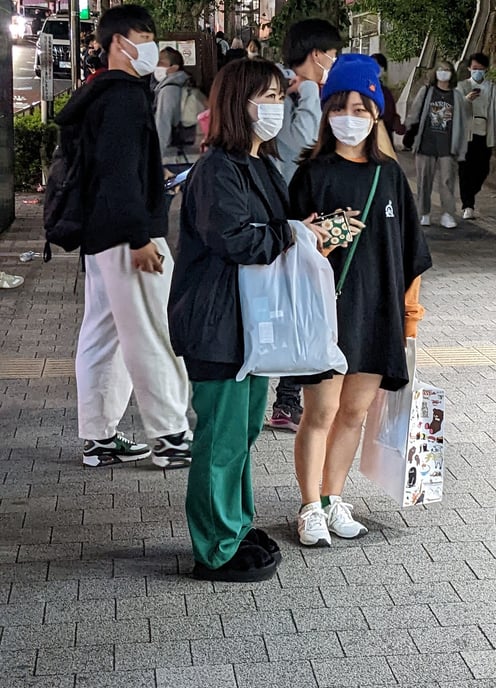

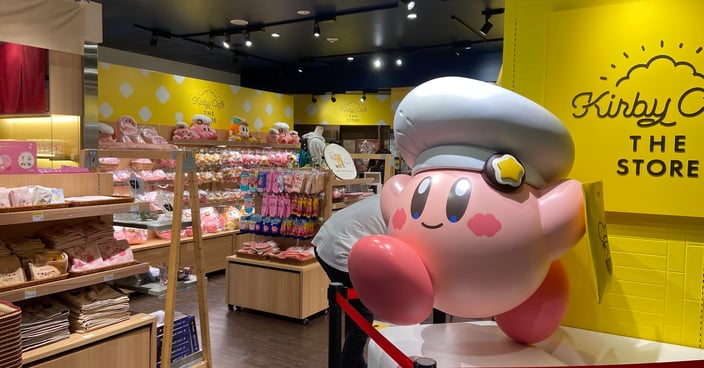

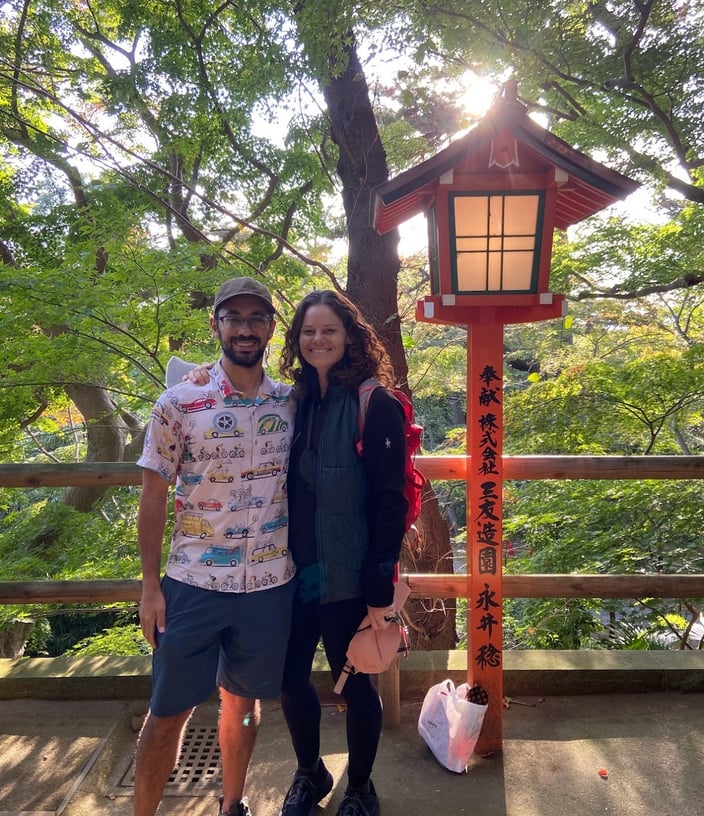

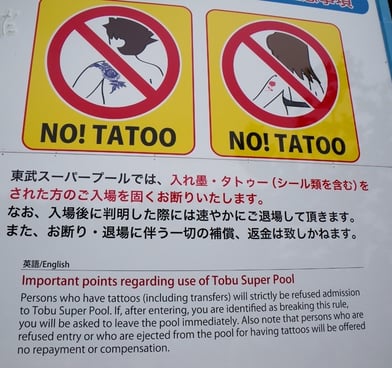

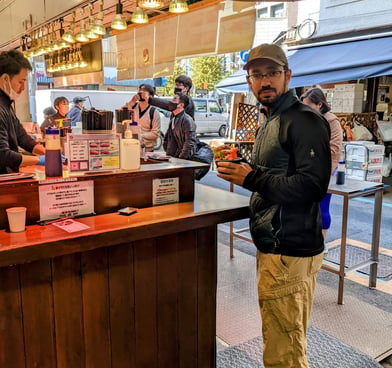



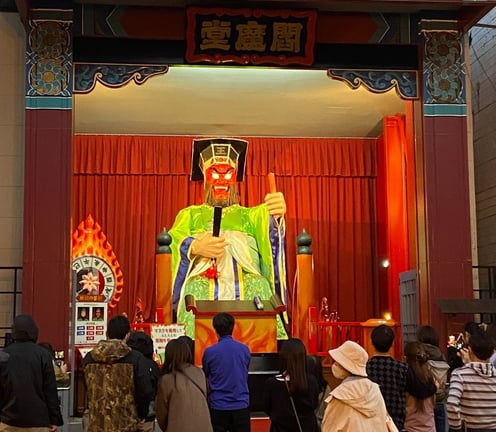

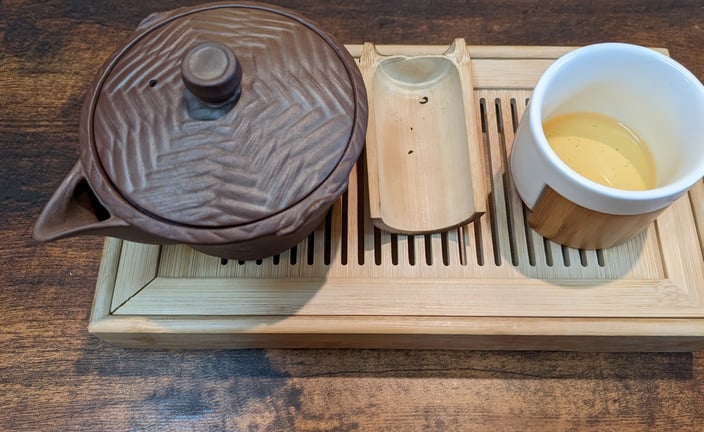

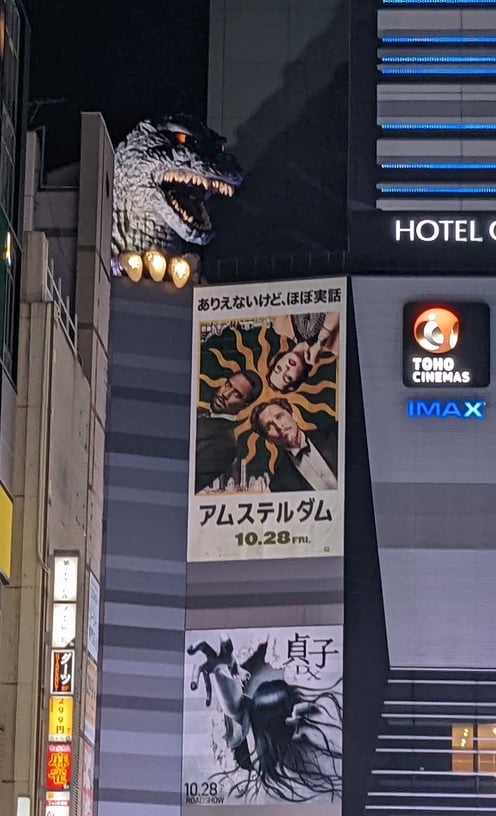

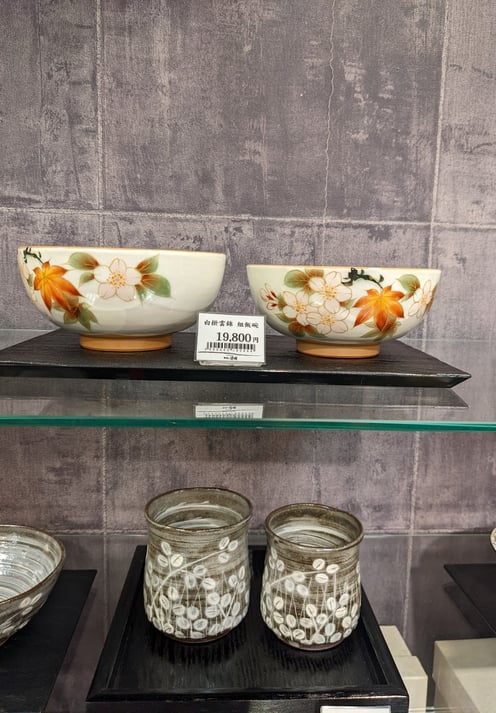

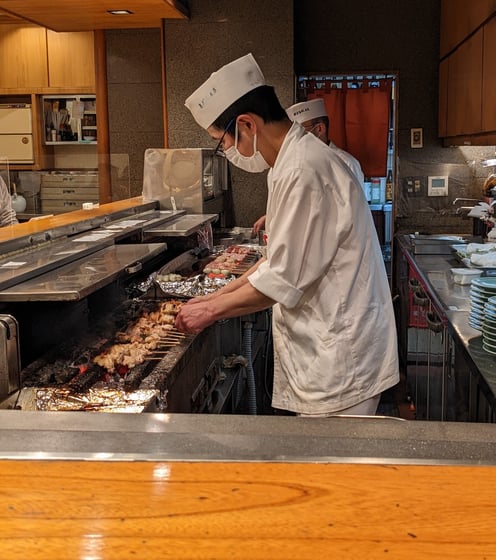

Even meat on sticks is executed with great precision and care.
It apparently important to have tea bowls decorated appropriately to each season.
No tattoos and many other rules of conduct governed use of bathhouses and onsen.
I wish I'd taken pictures of more of the no-no signs. Here Shadie eats in the designated location for this street stall.
Most countries have had COVID related floor signage. Only Japan expected people to face the corners in the elevator.
Isn't there something so retro about Godzilla in Tokyo?
I mean, Kirby never goes out of style.
Here we see two Japanese fashion trends, although neither to their extreme. Our leftside model wears fuzzy black platforms. Our rightside model wears an oversized shirt as a dress.
